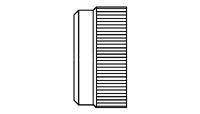Features: ·Energy Management Controller
·Based on 8-bit RISC Technology
·Proprietary Power Management Algorithm
·Reduces the power consumption of induction motor systems
·5V Operation
·18-pin PDIP and SOIC Packages
·8-bit Analog-to-Digital (A/D) Converter
·Automatic Power-on Reset
·Power-up Timer
·Commercial and Industrial Temperature Range Operation
·Multiple parts can be slaved for three-phase oper- ationPinout SpecificationsAbsolute Maximum Rating
SpecificationsAbsolute Maximum Rating 
Ambient temperature under bias............................................................-55 to +125
Storage Temperature............................................................................-65to +150
Voltage on any pin with respect to VSS (except VDD and RESET) .-0.6V to VDD +0.6V
Voltage on VDD with respect to VSS ...........................................................0 to +7.5V
Voltage on RESET with respect to VSS (Note 1)...........................................0 to +14V
Total power Dissipation (Note 2).....................................................................800mW
Max. Current out of VSS pin..............................................................................150mA
Max. Current into VDD pin.................................................................................100mA
Input Clamping Current, IIK (VI<0 or VI>VDD) ...............................................±20mA
Output Clamping Current, IOK (V0<0 or V0>VDD) ..........................................±20mA
Max. Output Current sunk by any I/O pin...........................................................25mA
Max. Output Current sourced by any I/O pin......................................................20mA
Note 1: Voltage spikes below VSS at the RESET pin, inducing currents greater than 80mA, may cause latch-up.
Thus, a series resistor of 50-100 should be used when applying a "low' level to the RESET pin rather than
pulling this pin directly to VSS.
Note 2: Total power dissipation should not exceed 800 mW for the package. Power dissipation is calculated as fol-lows:
PDIS = VDD x {IDD - IOH} + {(VDD-VOH) x IOH} + (VOL x IOL)
DescriptionThe MTE1122 is Single-phase induction motors run most efficiently at full load. As the applied load lessens, a greater portion of the energy consumed by the motor is wasted, mostly as heat.
The MTE1122 is estimated by the EPA that 50% of the energy pro- duced in the US is consumed by small electric motors, and that 20% of this energy does no useful work. There are perhaps three major reasons for this:
1.Over-specification -- sometimes its easier or costs no more to specify a larger motor than determine actual loads.
2.Worst case design -- pumps, conveyers, fans, and the like must be able to operate properly with clogged filters, maximum heads, or speci- fied loads. If filters are clean, or loads are lower, the motor will be running only partly loaded.
3.Idle time -- many times, systems can!t be shu down conveniently when not in use.
Number 1 above can be corrected by proper design. For example, in modern refrigerators, the compressor systems have been optimized quite effectively. Num- bers 2 and 3 can not be improved using traditional approaches. This is where the MTE1122 provides a new, cost-effective solution.
The MTE1122 calculates the amount of load on a motor connected to it, and adjusts the motor!s supply voltag to match that load. For example, if the load is lower than the motor!s rated load, the voltage to the moto can be reduced, thus decreasing the energy used by the motor. A 1/3 HP motor will typically see 85 VAC at no load when powered through the MTE1122, for an energy savings of as much as 58%.
A system block diagram is shown in Figure1. A graph of energy savings vs. motor load is shown in Figure2.
A graph of motor efficiency with and without an MTE1122-based energy management controller (EMC) is shown in Figure3. The data for the graphs are shown in Table1. These figures are based on a 1/3 HP induction motor coupled to a dynamometer. Actual savings may vary based on motor size, motor load and motor construction.

 MTE1122 Data Sheet
MTE1122 Data Sheet








